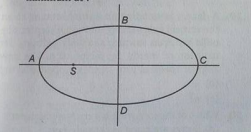Define orbital velocity. Derive an expression for the orbital velocity of a satellite revolving around a planet
Step-by-Step Solution
Step 1: Define Orbital Velocity
Orbital velocity is defined as the velocity at which an object (such as a satellite) must travel to maintain a stable orbit around a celestial body (such as a planet). This velocity allows the satellite to balance the gravitational pull of the planet with its own inertia, preventing it from falling into the planet or drifting away into space.
Step 2: Consider the Forces Acting on the Satellite
When a satellite is in orbit, it experiences two main forces:
- The gravitational force acting towards the planet.
- The centripetal force required to keep the satellite in circular motion.
For a satellite of mass m revolving around a planet of mass M at a distance r from the center of the planet, the gravitational force Fg can be expressed using Newton's law of gravitation:
Fg=GMmr2
where G is the universal gravitational constant.
Step 3: Apply the Centripetal Force Requirement
The centripetal force Fc required to keep the satellite in circular motion is given by:
Fc=mv2r
where v is the orbital velocity of the satellite.
Step 4: Set the Gravitational Force Equal to the Centripetal Force
For the satellite to remain in orbit, the gravitational force must equal the centripetal force:
GMmr2=mv2r
Step 5: Simplify the Equation
We can cancel the mass of the satellite m from both sides of the equation (assuming m≠0):
GMr2=v2r
Multiplying both sides by r gives:
GMr=v2
Step 6: Solve for Orbital Velocity
Taking the square root of both sides, we find the expression for the orbital velocity v:
v=√GMr
Final Expression
Thus, the orbital velocity of a satellite revolving around a planet is given by:
v=√GMr
---
Orbital velocity is defined as the velocity at which an object (such as a satellite) must travel to maintain a stable orbit around a celestial body (such as a planet). This velocity allows the satellite to balance the gravitational pull of the planet with its own inertia, preventing it from falling into the planet or drifting away into space.
When a satellite is in orbit, it experiences two main forces:
- The gravitational force acting towards the planet.
- The centripetal force required to keep the satellite in circular motion.
Fg=GMmr2
where G is the universal gravitational constant.
The centripetal force Fc required to keep the satellite in circular motion is given by:
Fc=mv2r
where v is the orbital velocity of the satellite.
For the satellite to remain in orbit, the gravitational force must equal the centripetal force:
GMmr2=mv2r
We can cancel the mass of the satellite m from both sides of the equation (assuming m≠0):
GMr2=v2r
Multiplying both sides by r gives:
GMr=v2
Taking the square root of both sides, we find the expression for the orbital velocity v:
v=√GMr
Thus, the orbital velocity of a satellite revolving around a planet is given by:
v=√GMr
Topper's Solved these Questions
Similar Questions
A satellite revolving around the earth is
View SolutionDefine orbital velocity of a satellite. Derive expressions for the orbital velocity of a satellite. Show that the escape velocity of a body from the earth's surface is √2 times its velocity in a circular orbit just above the earth's surface.
View Solution
Knowledge Check
If υe denotes escape velocity and V0 denotes orbital velocity of a satellite revolving around a planet of radius R, then
Aυe=√2.υoBυe=2υoC2υe=υoD√2.υe=υoIf ve denotes escape velocity and V0 denotes orbital velocity of a satellite revolving around a planet of radius R, then
Ave=√2⋅voBve=2voC2ve=voD√2⋅ve=voIf v0 be the orbital velocity of an articial satellite orbital velocity of the same satellite orbiting at an altitude equal to earth's radius is
Av0√23Bv0√32Cv0√2Dv0√2
Obtain an expression for the critical velocity of a satellite orbiting around the Earth.
View SolutionObtain an expressing for critical velocity of a satellite orbiting around the earth.
View SolutionWhat do you underestand by orbital velocity ? Derive an expression for the orbital velocity of a satellite.
View SolutionThe areal velocity of the planets revolving around the sun is ………….. .
View SolutionThe orbital velocity of the planet will be minimum at :

View Solution
